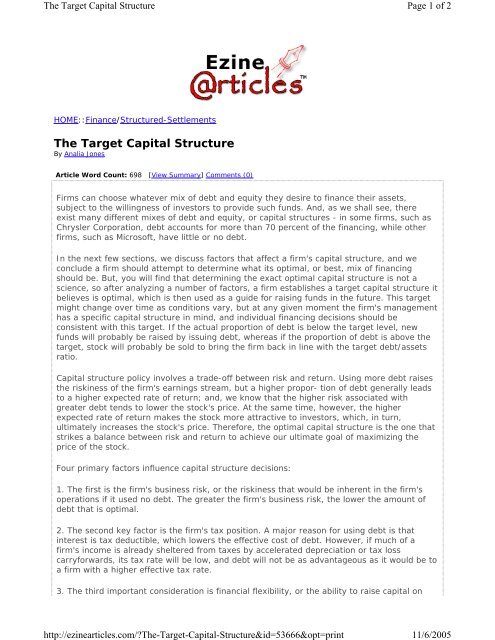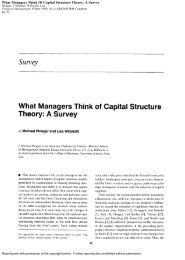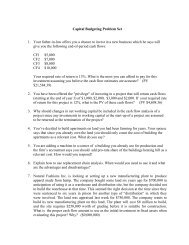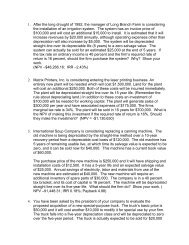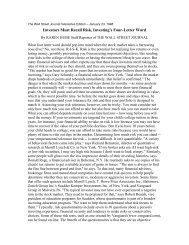The Target Capital Structure
The Target Capital Structure - Building The Pride
The Target Capital Structure - Building The Pride
You also want an ePaper? Increase the reach of your titles
YUMPU automatically turns print PDFs into web optimized ePapers that Google loves.
<strong>The</strong> <strong>Target</strong> <strong>Capital</strong> <strong>Structure</strong><br />
http://ezinearticles.com/?<strong>The</strong>-<strong>Target</strong>-<strong>Capital</strong>-<strong>Structure</strong>&id=53666&opt=print<br />
Page 1 of 2<br />
11/6/2005<br />
HOME::Finance/<strong>Structure</strong>d-Settlements<br />
<strong>The</strong> <strong>Target</strong> <strong>Capital</strong> <strong>Structure</strong><br />
By Analia Jones<br />
Article Word Count: 698 [View Summary] Comments (0)<br />
Firms can choose whatever mix of debt and equity they desire to finance their assets,<br />
subject to the willingness of investors to provide such funds. And, as we shall see, there<br />
exist many different mixes of debt and equity, or capital structures - in some firms, such as<br />
Chrysler Corporation, debt accounts for more than 70 percent of the financing, while other<br />
firms, such as Microsoft, have little or no debt.<br />
In the next few sections, we discuss factors that affect a firm's capital structure, and we<br />
conclude a firm should attempt to determine what its optimal, or best, mix of financing<br />
should be. But, you will find that determining the exact optimal capital structure is not a<br />
science, so after analyzing a number of factors, a firm establishes a target capital structure it<br />
believes is optimal, which is then used as a guide for raising funds in the future. This target<br />
might change over time as conditions vary, but at any given moment the firm's management<br />
has a specific capital structure in mind, and individual financing decisions should be<br />
consistent with this target. If the actual proportion of debt is below the target level, new<br />
funds will probably be raised by issuing debt, whereas if the proportion of debt is above the<br />
target, stock will probably be sold to bring the firm back in line with the target debt/assets<br />
ratio.<br />
<strong>Capital</strong> structure policy involves a trade-off between risk and return. Using more debt raises<br />
the riskiness of the firm's earnings stream, but a higher propor- tion of debt generally leads<br />
to a higher expected rate of return; and, we know that the higher risk associated with<br />
greater debt tends to lower the stock's price. At the same time, however, the higher<br />
expected rate of return makes the stock more attractive to investors, which, in turn,<br />
ultimately increases the stock's price. <strong>The</strong>refore, the optimal capital structure is the one that<br />
strikes a balance between risk and return to achieve our ultimate goal of maximizing the<br />
price of the stock.<br />
Four primary factors influence capital structure decisions:<br />
1. <strong>The</strong> first is the firm's business risk, or the riskiness that would be inherent in the firm's<br />
operations if it used no debt. <strong>The</strong> greater the firm's business risk, the lower the amount of<br />
debt that is optimal.<br />
2. <strong>The</strong> second key factor is the firm's tax position. A major reason for using debt is that<br />
interest is tax deductible, which lowers the effective cost of debt. However, if much of a<br />
firm's income is already sheltered from taxes by accelerated depreciation or tax loss<br />
carryforwards, its tax rate will be low, and debt will not be as advantageous as it would be to<br />
a firm with a higher effective tax rate.<br />
3. <strong>The</strong> third important consideration is financial flexibility, or the ability to raise capital on
<strong>The</strong> <strong>Target</strong> <strong>Capital</strong> <strong>Structure</strong><br />
http://ezinearticles.com/?<strong>The</strong>-<strong>Target</strong>-<strong>Capital</strong>-<strong>Structure</strong>&id=53666&opt=print<br />
Page 2 of 2<br />
11/6/2005<br />
reasonable terms under adverse conditions. Corporate treasurers know that a steady supply<br />
of capital is necessary for stable operations, which, in turn, are vital for long-run success.<br />
<strong>The</strong>y also know that when money is tight in the economy, or when a firm is experiencing<br />
operating difficulties, a strong balance sheet is needed to obtain funds from suppliers of<br />
capital. Thus, it might be advantageous to issue equity to strengthen the firm's capital base<br />
and financial stability.<br />
4. <strong>The</strong> fourth debt-determining factor has to do with managerial attitude (conservatism or<br />
aggressiveness) with regard to borrowing. Some managers are more aggressive than others,<br />
hence some firms are more inclined to use debt in an effort to boost profits. This factor does<br />
not affect the optimal, or value- maximizing, capital structure, but it does influence the<br />
target capital structure a firm actually establishes.<br />
<strong>The</strong>se four points largely determine the target capital structure, but, as we shall see,<br />
operating conditions can cause the actual capital structure to vary from the target at any<br />
given time. For example, as discussed in the Managerial Perspective at the beginning of the<br />
chapter, the debt/assets ratio of Unisys clearly has been . much higher than its target, and<br />
the company has taken some significant correc- tive actions in recent years to improve its<br />
financial position.<br />
Analia Jones is a Business Developer Manager of http://www.my-mortgege-loans.co.uk<br />
http://www.my-mortgage-loans.com<br />
http://www.2-structured-settlement.com<br />
Article Source: http://EzineArticles.com/<br />
This article has been viewed 1429 time(s).<br />
Article Submitted On: July 24, 2005


